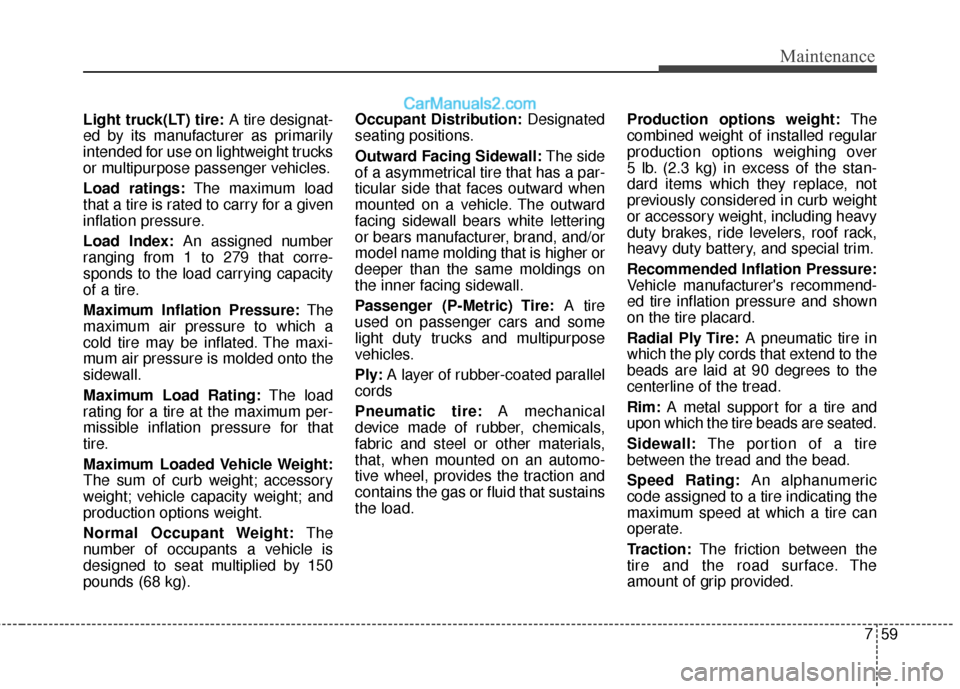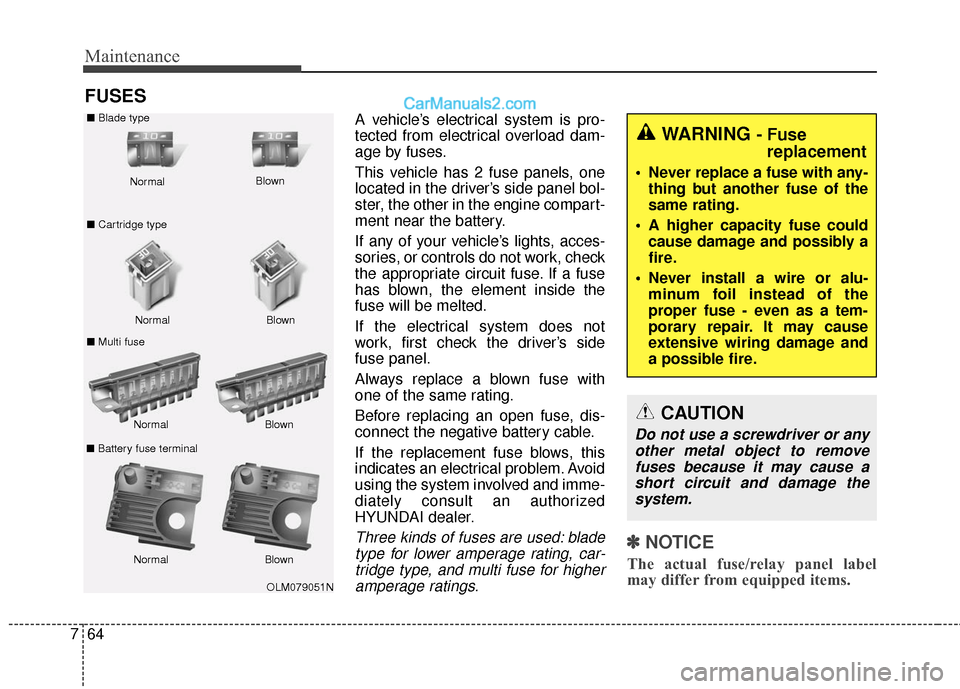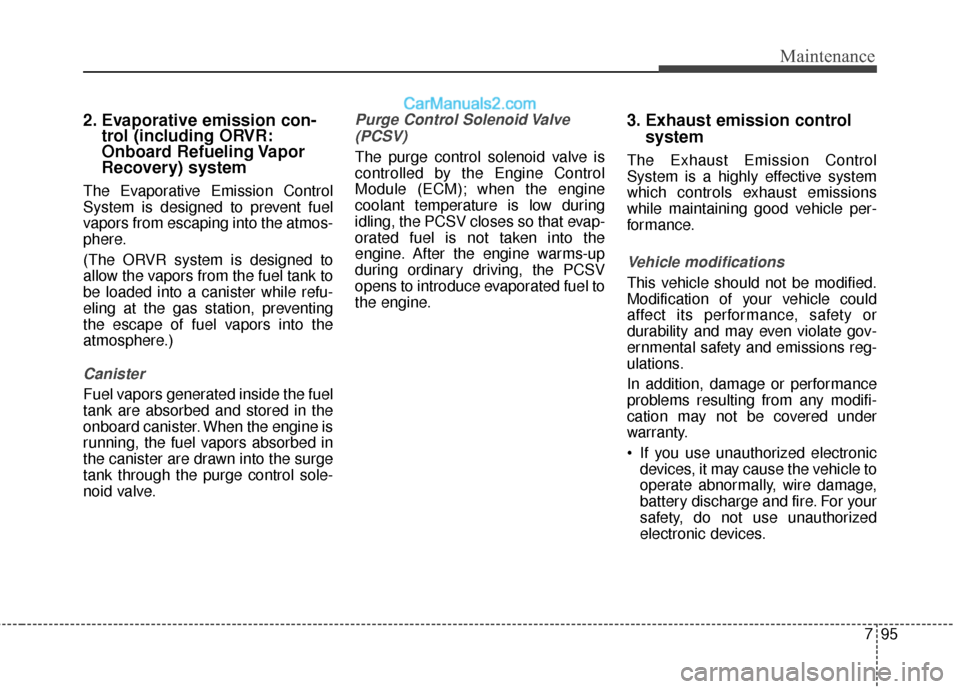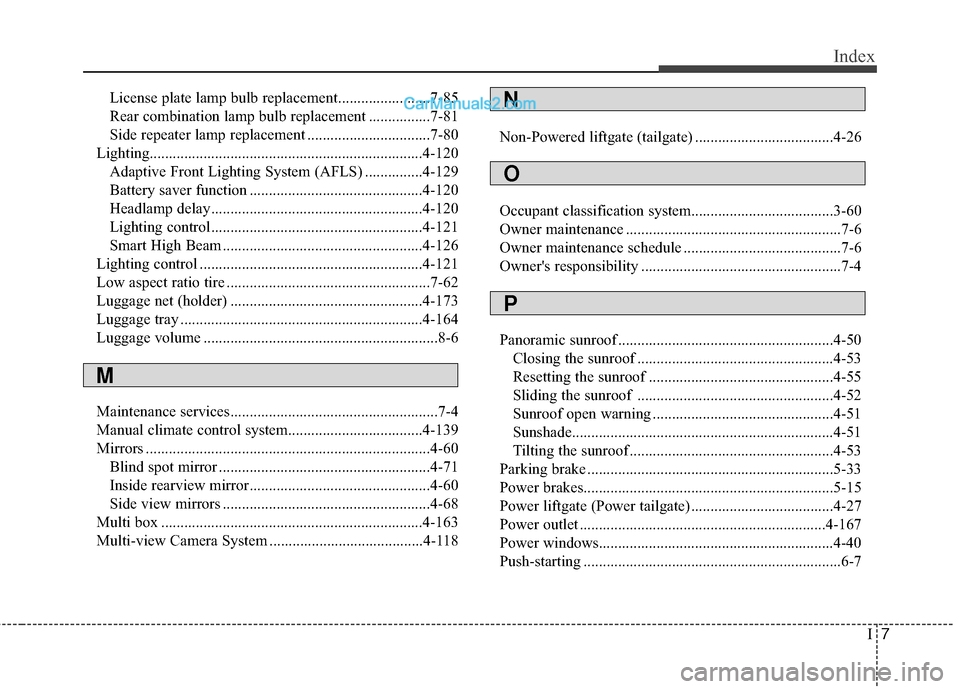2017 Hyundai Santa Fe battery
[x] Cancel search: batteryPage 507 of 569

759
Maintenance
Light truck(LT) tire:A tire designat-
ed by its manufacturer as primarily
intended for use on lightweight trucks
or multipurpose passenger vehicles.
Load ratings: The maximum load
that a tire is rated to carry for a given
inflation pressure.
Load Index: An assigned number
ranging from 1 to 279 that corre-
sponds to the load carrying capacity
of a tire.
Maximum Inflation Pressure: The
maximum air pressure to which a
cold tire may be inflated. The maxi-
mum air pressure is molded onto the
sidewall.
Maximum Load Rating: The load
rating for a tire at the maximum per-
missible inflation pressure for that
tire.
Maximum Loaded Vehicle Weight:
The sum of curb weight; accessory
weight; vehicle capacity weight; and
production options weight.
Normal Occupant Weight: The
number of occupants a vehicle is
designed to seat multiplied by 150
pounds (68 kg). Occupant Distribution:
Designated
seating positions.
Outward Facing Sidewall: The side
of a asymmetrical tire that has a par-
ticular side that faces outward when
mounted on a vehicle. The outward
facing sidewall bears white lettering
or bears manufacturer, brand, and/or
model name molding that is higher or
deeper than the same moldings on
the inner facing sidewall.
Passenger (P-Metric) Tire: A tire
used on passenger cars and some
light duty trucks and multipurpose
vehicles.
Ply: A layer of rubber-coated parallel
cords
Pneumatic tire: A mechanical
device made of rubber, chemicals,
fabric and steel or other materials,
that, when mounted on an automo-
tive wheel, provides the traction and
contains the gas or fluid that sustains
the load. Production options weight:
The
combined weight of installed regular
production options weighing over
5 lb. (2.3 kg) in excess of the stan-
dard items which they replace, not
previously considered in curb weight
or accessory weight, including heavy
duty brakes, ride levelers, roof rack,
heavy duty battery, and special trim.
Recommended Inflation Pressure:
Vehicle manufacturer's recommend-
ed tire inflation pressure and shown
on the tire placard.
Radial Ply Tire: A pneumatic tire in
which the ply cords that extend to the
beads are laid at 90 degrees to the
centerline of the tread.
Rim: A metal support for a tire and
upon which the tire beads are seated.
Sidewall: The portion of a tire
between the tread and the bead.
Speed Rating: An alphanumeric
code assigned to a tire indicating the
maximum speed at which a tire can
operate.
Traction: The friction between the
tire and the road surface. The
amount of grip provided.
Page 512 of 569

Maintenance
64
7
FUSES
A vehicle’s electrical system is pro-
tected from electrical overload dam-
age by fuses.
This vehicle has 2 fuse panels, one
located in the driver’s side panel bol-
ster, the other in the engine compart-
ment near the battery.
If any of your vehicle’s lights, acces-
sories, or controls do not work, check
the appropriate circuit fuse. If a fuse
has blown, the element inside the
fuse will be melted.
If the electrical system does not
work, first check the driver’s side
fuse panel.
Always replace a blown fuse with
one of the same rating.
Before replacing an open fuse, dis-
connect the negative battery cable.
If the replacement fuse blows, this
indicates an electrical problem. Avoid
using the system involved and imme-
diately consult an authorized
HYUNDAI dealer.
Three kinds of fuses are used: blade
type for lower amperage rating, car-tridge type, and multi fuse for higheramperage ratings.✽ ✽ NOTICE
The actual fuse/relay panel label
may differ from equipped items.
OLM079051N
Normal
Normal
■
Blade type
■ Cartridge type
■ Multi fuse Blown
Blown
Normal Blown
Normal Blown
WARNING - Fuse
replacement
Never replace a fuse with any-
thing but another fuse of the
same rating.
A higher capacity fuse could cause damage and possibly a
fire.
Never install a wire or alu- minum foil instead of the
proper fuse - even as a tem-
porary repair. It may cause
extensive wiring damage and
a possible fire.
CAUTION
Do not use a screwdriver or anyother metal object to removefuses because it may cause ashort circuit and damage thesystem.■ Battery fuse terminal
Page 515 of 569

767
Maintenance
3. Check the removed fuse; replace itif it is blown. To remove or insert
the fuse, use the fuse puller in the
engine compartment fuse panel.
4. Push in a new fuse of the same rating, and make sure it fits tightly
in the clips. If it fits loosely, consult
an authorized HYUNDAI dealer.Multi fuse
If the multi fuse is blown, it must be
removed as follows:
1. Disconnect the negative batterycable.
2. Remove the bolts shown in the picture above.
3. Replace the fuse with a new one of the same rating.
4. Reinstall in the reverse order of removal.
✽ ✽NOTICE
If the multi fuse is blown, consult an
Authorized HYUNDAI Dealer.
Main fuse
If the main fuse is blown, it must be
removed as follows:
1. Disconnect the negative battery
cable.
2. Remove the nuts shown in the pic- ture above.
3. Replace the fuse with a new one of the same rating.
4. Reinstall in the reverse order of removal.
ONCNMC2033ONCDMC2037
CAUTION
After checking the fuse box inthe engine compartment,securely install the fuse boxcover. If not, electrical failuresmay occur from water leaking in.
Page 523 of 569

775
Maintenance
DescriptionFuse ratingProtected Component
FUSE
POWER TAILGATE30APower Tail Gate Module
IDB15AIDB Module
4WD20A4WD ECM
AMS10ABattery Sensor
AMS (WIPER)10ABCM, PCM
WIPER FRT25AWiper LO Relay, Front Wiper Motor
B/UP LAMP10AA/T - Rear Combination Lamp (IN) LH/RH, Electro Chromic Mirror, Audio, A/V & Navigation
Head Unit
ABS37.5AESC Module
5 SENSOR7.5APCM
TCU15AA/T : Transaxle Range Switch
F/PUMP15AFuel Pump Relay
1 ECU 15APCM
2 ECU10AIDB Module
3 SENSOR10AFuel Pump Relay
IGN COIL20ACondenser, Ignition Coil #1/#2/#3/#4
2 SENSOR10APurge Control Solenoid Valve, Variable Intake Solenoid Valve(G4KJ), Oil Control Valve #1/#2
1 SENSOR15AOxygen sensor(#1/#2/#3/#4), PCM, Oxygen Sensor(Down), E/R Fuse & Relay Box (Cooling
Fan Relay)
B/A HORN10ABurgl Aralarm Horn Relay
Page 543 of 569

795
Maintenance
2. Evaporative emission con-trol (including ORVR:
Onboard Refueling Vapor
Recovery) system
The Evaporative Emission Control
System is designed to prevent fuel
vapors from escaping into the atmos-
phere.
(The ORVR system is designed to
allow the vapors from the fuel tank to
be loaded into a canister while refu-
eling at the gas station, preventing
the escape of fuel vapors into the
atmosphere.)
Canister
Fuel vapors generated inside the fuel
tank are absorbed and stored in the
onboard canister. When the engine is
running, the fuel vapors absorbed in
the canister are drawn into the surge
tank through the purge control sole-
noid valve.
Purge Control Solenoid Valve
(PCSV)
The purge control solenoid valve is
controlled by the Engine Control
Module (ECM); when the engine
coolant temperature is low during
idling, the PCSV closes so that evap-
orated fuel is not taken into the
engine. After the engine warms-up
during ordinary driving, the PCSV
opens to introduce evaporated fuel to
the engine.
3. Exhaust emission control system
The Exhaust Emission Control
System is a highly effective system
which controls exhaust emissions
while maintaining good vehicle per-
formance.
Vehicle modifications
This vehicle should not be modified.
Modification of your vehicle could
affect its performance, safety or
durability and may even violate gov-
ernmental safety and emissions reg-
ulations.
In addition, damage or performance
problems resulting from any modifi-
cation may not be covered under
warranty.
If you use unauthorized electronic
devices, it may cause the vehicle to
operate abnormally, wire damage,
battery discharge and fire. For your
safety, do not use unauthorized
electronic devices.
Page 560 of 569

Index
2I
AC inverter .................................................................4-169
Active ECO system ....................................................5-100
Adaptive Front Lighting System (AFLS)...................4-129
Advanced smart cruise control system .........................5-72
Air bag - advanced supplemental restraint system.......3-53Additional safety precautions....................................3-80
Air bag warning label................................................3-82
Air bag warning light ................................................3-56
Curtain air bag...........................................................3-72
Driver's and passenger's front air bag .......................3-66
How does the air bag system operate .......................3-54
Main components of occupant classification system ....................................................................3-61\
Occupant classification system .................................3-60
Side air bag................................................................3-71
SRS Care ...................................................................3-79
SRS components and functions ................................3-57
Air cleaner ....................................................................7-38\
Air conditioning system .................................................8-6
All Wheel Drive (AWD) ..............................................5-22
Antenna .......................................................................4\
-177
Anti-lock Brake System (ABS) ....................................5-44
Appearance care ...........................................................7-87 Exterior care ..............................................................7-87
Interior care ...............................................................7-93 Audio system ..............................................................4-177
Antenna ...................................................................4-177\
Audio / Video / Navigation system (AVN) .............4-178
Caring for CDs ........................................................4-181
How vehicle audio works........................................4-179
Steering wheel audio control...................................4-177
Auto hold ......................................................................5-\
41
Automatic climate control system ..............................4-149
Automatic emergency braking (AEB) ..........................5-56
Automatic transaxle ......................................................5-15
Aux, USB and iPod
®port...........................................4-172
Battery.................................................................\
..........7-45
Before driving .................................................................5-4
Blind spot detection system (BSD) ..............................5-88
Blind spot mirror ..........................................................4-71
Brake fluid ....................................................................7-35\
Brake system............................................................\
.....5-31 Anti-lock Brake System (ABS) ................................5-44
Auto hold...................................................................5-41
Downhill Brake Control (DBC) ................................5-51
Electronic parking brake (EPB) ................................5-35
Electronic Stability Control (ESC) ...........................5-46
Emergency braking ...................................................5-40
Good braking practices .............................................5-54
A
B
Page 565 of 569

I7
Index
License plate lamp bulb replacement........................7-85
Rear combination lamp bulb replacement ................7-81
Side repeater lamp replacement ................................7-80
Lighting................................................................\
.......4-120 Adaptive Front Lighting System (AFLS) ...............4-129
Battery saver function .............................................4-120
Headlamp delay.......................................................4-120
Lighting control.......................................................4-121
Smart High Beam ....................................................4-126
Lighting control ..........................................................4-121
Low aspect ratio tire .....................................................7-62
Luggage net (holder) ..................................................4-173
Luggage tray ...............................................................4-164
Luggage volume .............................................................8-6
Maintenance services......................................................7-4
Manual climate control system...................................4-139
Mirrors ........................................................................\
..4-60 Blind spot mirror .......................................................4-71
Inside rearview mirror...............................................4-60
Side view mirrors ......................................................4-68
Multi box ....................................................................4-16\
3
Multi-view Camera System ........................................4-118 Non-Powered liftgate (tailgate) ....................................4-26
Occupant classification system.....................................3-60
Owner maintenance ........................................................7-6
Owner maintenance schedule .........................................7-6
Owner's responsibility ....................................................7-4
Panoramic sunroof ........................................................4-50
Closing the sunroof ...................................................4-53
Resetting the sunroof ................................................4-55
Sliding the sunroof ...................................................4-52
Sunroof open warning ...............................................4-51
Sunshade....................................................................4-51\
Tilting the sunroof .....................................................4-53
Parking brake ................................................................5-33
Power brakes............................................................\
.....5-15
Power liftgate (Power tailgate) .....................................4-27
Power outlet ................................................................4-167
Power windows...........................................................\
..4-40
Push-starting ...................................................................6-7
M
N
O
P